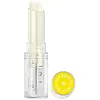What's inside
What's inside
 Key Ingredients
Key Ingredients

 Benefits
Benefits

 Concerns
Concerns

 Ingredients Side-by-side
Ingredients Side-by-side

Butyl Methoxydibenzoylmethane 3%
UV AbsorberHomosalate 9%
Skin ConditioningEthylhexyl Salicylate 5%
UV AbsorberOctocrylene 9%
UV AbsorberOctyldodecanol
EmollientC12-15 Alkyl Benzoate
AntimicrobialRicinus Communis Seed Oil
MaskingDiisostearyl Malate
EmollientAroma
Dibutyl Lauroyl Glutamide
Skin ConditioningPhenethyl Benzoate
EmollientDibutyl Ethylhexanoyl Glutamide
Skin ConditioningSilica Silylate
EmollientBrassica Campestris/Aleurites Fordi Oil Copolymer
Skin ConditioningOctyldodecyl Neopentanoate
EmollientSaccharin
MaskingTocopherol
AntioxidantEuterpe Oleracea Fruit Oil
Skin ConditioningButyl Methoxydibenzoylmethane 3%, Homosalate 9%, Ethylhexyl Salicylate 5%, Octocrylene 9%, Octyldodecanol, C12-15 Alkyl Benzoate, Ricinus Communis Seed Oil, Diisostearyl Malate, Aroma, Dibutyl Lauroyl Glutamide, Phenethyl Benzoate, Dibutyl Ethylhexanoyl Glutamide, Silica Silylate, Brassica Campestris/Aleurites Fordi Oil Copolymer, Octyldodecyl Neopentanoate, Saccharin, Tocopherol, Euterpe Oleracea Fruit Oil
Butyrospermum Parkii Butter
Skin ConditioningDiisostearyl Malate
EmollientPolyglyceryl-2 Triisostearate
EmulsifyingOctyldodecanol
EmollientMicrocrystalline Wax
Emulsion StabilisingEthylhexyl Methoxycinnamate
UV AbsorberRicinus Communis Seed Oil
MaskingCeresin
Emulsion StabilisingEthylhexyl Salicylate
UV AbsorberMeadowfoam Delta-Lactone
Skin ConditioningEuphorbia Cerifera Wax
Ozokerite
Emulsion StabilisingParaffin
PerfumingPolybutene
Jojoba Esters
EmollientOlea Europaea Fruit Oil
MaskingPolyethylene
AbrasiveSorbitan Sesquioleate
EmulsifyingPrunus Amygdalus Dulcis Oil
Skin ConditioningTribehenin
EmollientPolyglyceryl-6 Polyricinoleate
EmulsifyingRosa Damascena Flower Oil
MaskingOenothera Biennis Oil
EmollientCamellia Japonica Seed Oil
EmollientLimnanthes Alba Seed Oil
Skin ConditioningPrunus Armeniaca Kernel Oil
MaskingElaeis Guineensis Oil
EmollientCarthamus Tinctorius Seed Oil
MaskingHelianthus Annuus Seed Oil
EmollientTrihydroxystearin
Skin ConditioningTocopherol
AntioxidantDehydroacetic Acid
PreservativeParfum
MaskingButyrospermum Parkii Butter, Diisostearyl Malate, Polyglyceryl-2 Triisostearate, Octyldodecanol, Microcrystalline Wax, Ethylhexyl Methoxycinnamate, Ricinus Communis Seed Oil, Ceresin, Ethylhexyl Salicylate, Meadowfoam Delta-Lactone, Euphorbia Cerifera Wax, Ozokerite, Paraffin, Polybutene, Jojoba Esters, Olea Europaea Fruit Oil, Polyethylene, Sorbitan Sesquioleate, Prunus Amygdalus Dulcis Oil, Tribehenin, Polyglyceryl-6 Polyricinoleate, Rosa Damascena Flower Oil, Oenothera Biennis Oil, Camellia Japonica Seed Oil, Limnanthes Alba Seed Oil, Prunus Armeniaca Kernel Oil, Elaeis Guineensis Oil, Carthamus Tinctorius Seed Oil, Helianthus Annuus Seed Oil, Trihydroxystearin, Tocopherol, Dehydroacetic Acid, Parfum
 Reviews
Reviews

Ingredients Explained
These ingredients are found in both products.
Ingredients higher up in an ingredient list are typically present in a larger amount.
Diisostearyl Malate is an emollient and most often used in lip products. It comes from isostearyl alcohol, a fatty acid, and malic acid, an AHA.
As an emollient, Diisostearyl Malate helps create a thin film on your skin to trap moisture in. This helps keep your skin soft and smooth.
Ethylhexyl Salicylate is an organic compound used to block UV rays. It primarily absorbs UVB rays but offers a small amount of UVA protection as well.
Commonly found in sunscreens, Ethylhexyl Salicylate is created from salicylic acid and 2-ethylhexanol. You might know salicylic acid as the effective acne fighter ingredient and BHA.
The ethylhexanol in this ingredient is a fatty alcohol and helps hydrate your skin, similar to oils. It is an emollient, which means it traps moisture into the skin.
According to manufacturers, Ethylhexyl Salicylate absorbs UV wavelength of 295-315 nm, with a peak absorption at 307-310 nm. UVA rays are linked to long term skin damage, such as hyperpigmentation. UVB rays emit more energy and are capable of damaging our DNA. UVB rays cause sunburn.
Learn more about Ethylhexyl SalicylateOctyldodecanol is a fatty alcohol. It is primarily used to enhance the texture of products.
As an emulsifier, Octyldodecanol helps prevent the oils and waters from separating. It also prevents ingredients from creating foam when shaken.
Octyldodecanol is created by reducing fatty acid to an alcohol.
Due to its high molecular weight, it does not get absorbed into the skin.
Learn more about OctyldodecanolRicinus Communis Seed Oil is the INCI name for castor oil.
Castor Oil helps moisturize the skin. It is rich in a fatty acid called ricinoleic acid. This fatty acid helps prevent moisture loss on the skin. This helps keep your skin soft and hydrated. Ricinoleic acid also has anti-inflammatory and pain reducing properties.
Besides hydrating the skin, castor oil is also used to hydrate hair. By keeping the hair shaft moisturized, breakage is decreased. More studies are needed to show castor oil's effective on stimulating hair growth.
Castor oil is created by cold-pressing castor seeds and then purifying the oil with heat. It was used in Ancient Egypt as fuel in lamps and to help treat eye irritation.
The term 'fragrance' is not regulated in many countries. In many cases, it is up to the brand to define this term. For instance, many brands choose to label themselves as "fragrance-free" because they are not using synthetic fragrances. However, their products may still contain ingredients such as essential oils that are considered a fragrance.
Learn more about Ricinus Communis Seed OilTocopherol (also known as Vitamin E) is a common antioxidant used to help protect the skin from free-radicals and strengthen the skin barrier. It's also fat soluble - this means our skin is great at absorbing it.
Vitamin E also helps keep your natural skin lipids healthy. Your lipid skin barrier naturally consists of lipids, ceramides, and fatty acids. Vitamin E offers extra protection for your skin’s lipid barrier, keeping your skin healthy and nourished.
Another benefit is a bit of UV protection. Vitamin E helps reduce the damage caused by UVB rays. (It should not replace your sunscreen). Combining it with Vitamin C can decrease sunburned cells and hyperpigmentation after UV exposure.
You might have noticed Vitamin E + C often paired together. This is because it is great at stabilizing Vitamin C. Using the two together helps increase the effectiveness of both ingredients.
There are often claims that Vitamin E can reduce/prevent scarring, but these claims haven't been confirmed by scientific research.
Learn more about Tocopherol